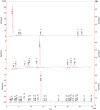Recovery and partial isolation of ⍺-mangostin from mangosteen pericarpsvia sequential extraction and precipitation
- PMID: 39453921
- PMCID: PMC11508469
- DOI: 10.1371/journal.pone.0310453
Recovery and partial isolation of ⍺-mangostin from mangosteen pericarpsvia sequential extraction and precipitation
Abstract
This study introduced an innovative sequential extraction methodology designed for the efficient recovery of alpha-mangostin (⍺-M) from mangosteen pericarps. Alpha-mangostin, renowned for its pharmacological properties including anti-inflammatory, anti-cancer, and anti-bacterial effects, has garnered significant attention across diverse industries. The proposed method of sequential extraction achieved 73% recovery and a yield of 46.75 mg/g based on the weight/weight percentage of the mass of ⍺-M extracted from the sequence and the mass of raw material. Furthermore, the purity of the dried product was 67.9%. The sequence solvent extraction system, comprising water, hexane, and acetonitrile, plays a pivotal role in enhancing the efficacy of the extraction process. Notably, this methodology offers a cost-effective alternative to conventional extraction methods. It reduces the need for complex equipment and processes, positioning it as a resource-efficient extraction technique in comparison to existing methodologies. This novel sequential extraction method presents a promising avenue for the economical and sustainable recovery of alpha-mangostin (⍺-M) from pericarps.
Copyright: © 2024 Han et al. This is an open access article distributed under the terms of the Creative Commons Attribution License, which permits unrestricted use, distribution, and reproduction in any medium, provided the original author and source are credited.
Conflict of interest statement
The authors have declared that no competing interests exist.
Figures







Similar articles
-
Alpha-Mangostin-Rich Extracts from Mangosteen Pericarp: Optimization of Green Extraction Protocol and Evaluation of Biological Activity.Molecules. 2018 Jul 25;23(8):1852. doi: 10.3390/molecules23081852. Molecules. 2018. PMID: 30044450 Free PMC article.
-
From the Front or Back Door? Quantitative analysis of direct and indirect extractions of α-mangostin from mangosteen (Garcinia mangostana).PLoS One. 2018 Oct 15;13(10):e0205753. doi: 10.1371/journal.pone.0205753. eCollection 2018. PLoS One. 2018. PMID: 30321238 Free PMC article.
-
Combined microwave-assisted extraction and high-speed counter-current chromatography for separation and purification of xanthones from Garcinia mangostana.J Chromatogr B Analyt Technol Biomed Life Sci. 2011 Oct 15;879(28):3023-7. doi: 10.1016/j.jchromb.2011.08.040. Epub 2011 Sep 2. J Chromatogr B Analyt Technol Biomed Life Sci. 2011. PMID: 21925972
-
A Review of the Influence of Various Extraction Techniques and the Biological Effects of the Xanthones from Mangosteen (Garcinia mangostana L.) Pericarps.Molecules. 2022 Dec 10;27(24):8775. doi: 10.3390/molecules27248775. Molecules. 2022. PMID: 36557908 Free PMC article. Review.
-
Review of Garcinia mangostana and its Xanthones in Metabolic Syndrome and Related Complications.Phytother Res. 2017 Aug;31(8):1173-1182. doi: 10.1002/ptr.5862. Epub 2017 Jun 28. Phytother Res. 2017. PMID: 28656594 Review.
References
-
- Adriani L., Widjastuti T., Nurdianti R.R., and Wiradimadja R., Effects of mangosteen peel extract (Garcinia mangostana L.) on blood lipid of ntiox chicken growth phase. In Proceedings of the 3rd International Conference of Integrated Intellectual Community (ICONIC), Hannover, Germany, 27–29 April 2018; pp. 1–5.
-
- Charoenphun N., Setarnawat S., and Sai-Ut S., Chemical composition and trends in utilization of by-products and wastes from 4 types of tropical fruit processing. TJST, 2020. 28: p. 113–128.
-
- Mello R.F.A., Pinheiro W.B.S., Benjamim J.K.F., Siqueira F.C., Chiste R.C., and Santos A.S., A fast and efficient preparative method for separation and purification of main bioactive xanthones from the waste of Garcinia mangostana L. by high-speed countercurrent chromatography. Arab. J. Chem., 2021. 14: p. 103252.
-
- Widowati W., Ginting C.N., Lister N.E., Gisang E., Amalia A., Wibowo S.H.B., et al.., Anti-aging effects of mangosteen peel extract and its phytochemical compounds: Antioxidant activity, enzyme inhibition and molecular docking simulation. Trop. Life Sci. Res., 2020. 31: p. 127–144. doi: 10.21315/tlsr2020.31.3.9 - DOI - PMC - PubMed
-
- Chaiwong N., Phimolsiripol Y., Leelapornpisid P., Ruksiriwanich W., Jantanasakulwong K., Rachtanapun P., et al.., Synergistics of carboxymethyl chitosan and mangosteen extract as enhancing moisturizing, antioxidant, antibacterial, and deodorizing properties in emulsion cream. Polymers, 2022. 14: p. 178. doi: 10.3390/polym14010178 - DOI - PMC - PubMed
MeSH terms
Substances
LinkOut - more resources
Full Text Sources

